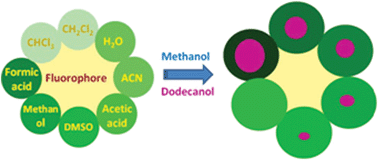The environmental effect on the fluorescence intensity in solution. An analytical model†
Abstract
In this paper a mathematical model describing the non-specific interactions of the medium surrounding a fluorophore on its fluorescence intensity is proposed. The model, which has been developed for quantitative analytical applications, is based on the following general ideas: (1) the medium affects the fluorescence quantum yield across the non-radiative decay constant (knr); (2) the knr can be simplified to the singlet-to-triplet intersystem crossing (kISC) constants; (3) kISC follows the energy gap law and then depends on the singlet and triplet energy difference, and (4) the medium, due to solvation, changes the energy of both excited levels (singlet and triplet), then the constants and finally the fluorescence intensity. In our model, the strength of the fluorophore solvation by the


 Please wait while we load your content...
Please wait while we load your content...